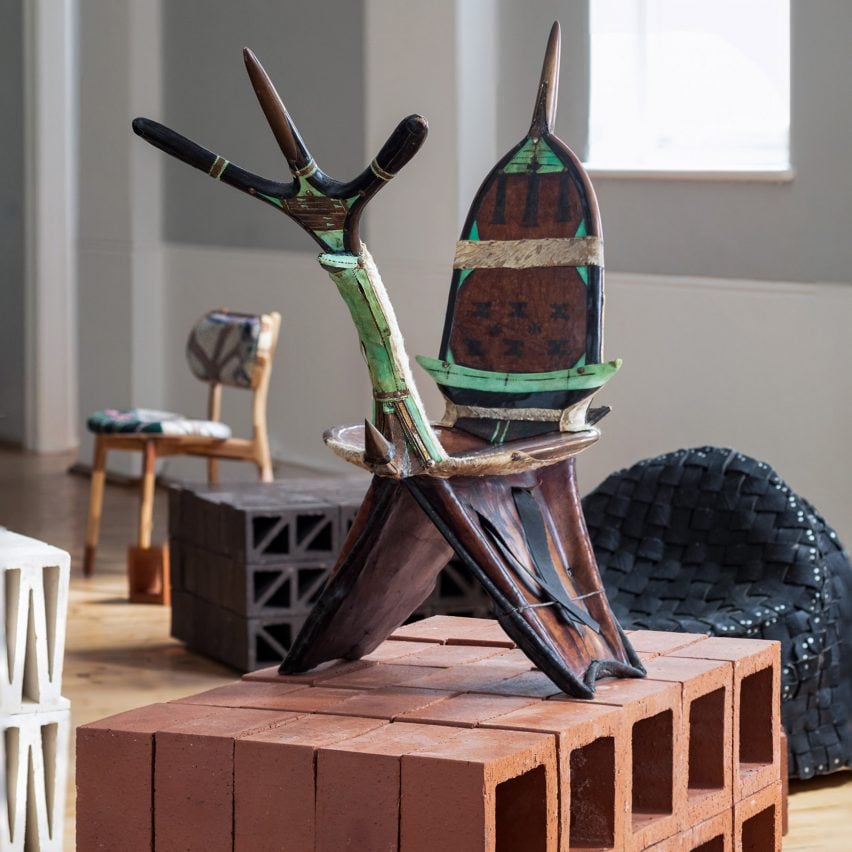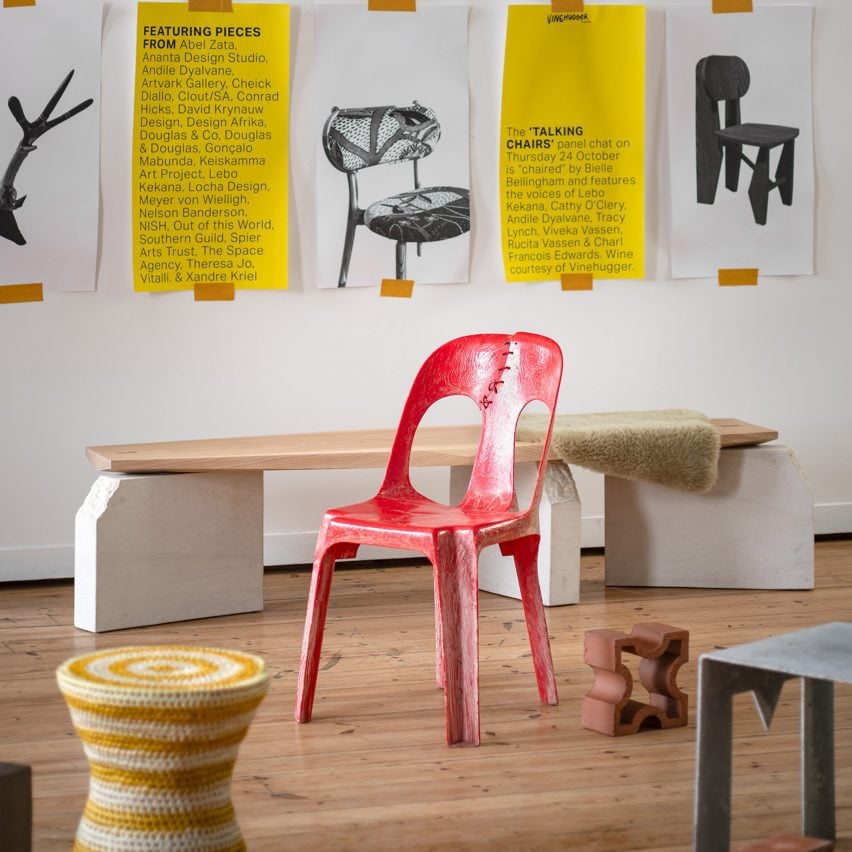
Ten chairs that tell the diverse stories of the African continent
The inaugural Design Week South Africa included an exhibition bringing together chairs from across the continent of Africa. Here the curators share 10 highlights, ranging from a red garden chair mended with electric wire to a throne made of guns.
Held at Orms' FORM Hall in Cape Town, the Africa Chair exhibition was curated by Marlon James Interior Architecture founder Marlon Leggat and creative content company Lookbook Studio, in response to an open call for events from Design Week South Africa.
"We wanted to showcase the ingenuity of African chair design, both historical and modern," said Leggat.
"At the same time, we wanted to encourage a conversation around design and what it means to be an African designer – the histories, the materials and the craftsmanship."

The curators were limited in what they could do. With just a few weeks to pull the exhibition together and no funding, they knew their exhibition would have a slant towards South African designers and chairs that were already in the country in the hands of collectors or galleries.
"It's not the definitive showcase, despite the name," said Lookbook co-founder and creative director Charl Edwards. "It's celebratory. It's a starting point."
"By no means did we capture every African chair that we think is worthy," Leggat added.
However, the show was carefully considered within these constraints, bringing together 32 chairs from 12 different countries. They were displayed alongside an installation of seating blocks by artist Lebo Kekana and furniture brand NISH.
These were arranged to reference the circular chair formation the area's Indigenous groups would traditionally make around a fire, and on opening night hosted a panel discussion intended to mirror these kinds of gatherings.
It was important to the curators to represent many nations and cultures, and to be comprehensive in what that representation looked like.
It is a problem, Edwards said, that objects from Africa are often exhibited in museums or collections with only the name of the country they came from and not the person who made it.

The exhibition's Log chair by Abel Zata, who comes from a family line of master wood sculptors in Zimbabwe, is one example of the kind of work that may have once been removed from its context without much thought, he said.
"To me, it brings attention to how many chairs there are here without names," said Edwards. "This is an example of where we know who it is by, but it could easily have just been another forgotten designer."
"Why are the other names not there?" he continued. "Why have the people who sourced these things not found out? It shows how in the past, people would just kind of steal and gather and grab and not really properly represent."
"Unfortunately, we don't know the names of all the designers, but that's also part of why we had the panel discussion – to contextualise the exhibit and voice the problems that we are aware of."
Here, Edwards and Leggat share the stories behind 10 of their highlights from the show:

Traditional Tuareg camel saddle, Niger, 19th century
"The starting point for this exhibition was actually this Tuareg saddle," said Leggat. "I'd seen it at an antique dealer locally and thought 'I need to somehow showcase this' because I don't think enough people have seen it, and I think it's beautifully made."
"Technically, it's not really a chair but it is a seat of sorts. I just love the intricate design and how delicately it's made with leather and copper and all sorts of things. Just from a purely aesthetic point of view, I was drawn to it."
"When I did some more research, I found out that these saddles are incredibly important to the Tuareg people because they have these massive trade routes through the Sahara Desert, and these saddles are a very important tool for them for trade."

Red plastic chair by unknown designer, South Africa
"This repaired chair was found in [the township of] Khayelitsha in 2013 and became part of a World Design Capital 2014 initiative called 'Yenza – Make it!' that we launched at Design Indaba to platform and spotlight makers that don't necessarily see themselves as designers," said Edwards.
"We happened to stumble upon this chair while we were driving. It literally stopped us in our tracks: the red wire stitching that was used to mend the broken part of a once ordinary and mass-produced red plastic chair."
"To me, this chair really represents African ingenuity and how something ordinary can become an item of beauty. It then became part of a group show that went to the Vitra Design Campus, so it got a lot of air time and, for us, became a symbol of the spirit of World Design Capital. We now cheekily call it the red plastic Vitra chair."

Log chair by Abel Zata, Zimbabwe, 2005
"There's a massive trend into brutalism at the moment, especially organic brutalism, and I think this fits that aesthetic," said Leggat. "It's just a log that's been reimagined into something practical and sculpturally beautiful."
"It's made from reclaimed mukwa wood, which is basically a type of teak. According to Binki Newman of Design Afrika, who knew Zata and brought the piece to South Africa, the artist would go to his neighbouring farms and gather fallen logs and other wood to carve chairs that fulfil a necessary function while being works of art, too."

Dumbia chair by Cheick Diallo, Mali, 2021
"Cheick is obviously an international superstar, no introduction needed," said Edwards. "He is represented by Southern Guild and that's where we actually got the chair."
"By weaving rope into patterned surfaces, Cheick skillfully merges form and texture, using tactile materials to enhance both aesthetic appeal and functionality. He's just incredible. We're so lucky that we could get him because I think you can't have the Africa Chair show and not have Cheick's work."

Boog chair by Xandre Kriel, South Africa, 2024
"The Boog chair is inspired by a leaf spring used in car suspension," said Leggat. "I appreciate how an everyday object could inspire something so unusual and beautiful."
"A continuous metal frame, the Boog chair is only made up of three components, balanced together to form the structure while requiring no fastenings," said Leggat. "The chair relies on the integrity of its materials and smart engineering to keep its form."

Mahamb'ehlala by Andile Dyalvane, South Africa, 2020
"This beautiful little ceramic vessel stool is part of the iThongo series that Andile created for Southern Guild," said Edwards. "His other pieces were larger and you could sit on them."
"The series is inspired by Xhosa culture. Each hand-coiled piece features iconography designed by Andile, expressing concepts like community, trauma and rebirth. It was first shown in his home village of Ngobozana and honoured Xhosa traditions with stools arranged ceremonially around a hearth. The chair in his context and culture represents a lot."

Masaruma stool by Ananta Design Studio, South Africa, 2023
"Ananta Design Studio is made up of two sisters and they are, I feel, at the forefront of challenging what the local aesthetic is in a very colourful and vibrant way," said Edwards. "This stool was inspired by the nostalgia of musical chairs and features a mushroom-shaped design crocheted from upcycled cassette tapes."
"The aesthetic is very modern and it feels like this is on par with what a lot of other young designers are doing internationally. When you look at it, it's not like 'oh, this is so African' or 'traditional African' – whatever that means."
"It could have been in Mexico, it could have been in Japan, it could have been anywhere. But when you look at their other furniture pieces and collections, it's very colourful and vibrant, and there's always a narrative and a story."

Traditional Burkinabé armchair, Burkina Faso, 2023
"I just love the texture of this chair," said Leggat. "It's once again literally two materials, wood and goat's leather. There's a lot of beauty in simplicity and a lot of difficulty in trying to execute something with simplicity. I think that speaks to really good design, if you can execute something with really minimal materials."
"This chair can be seen in and outside every home in Burkina Faso. It is designed for portability and offers practical, relaxed seating for social gatherings."

Inhominável Throne by Gonçalo Mabunda, Mozambique, 2012
"This chair is made out of disarmed weapons, sourced throughout Mozambique after the country's 20-year-long civil war," said Leggat. "Mabunda is an artist and anti-war activist, turning death to life through his work."
"It's powerful because this artwork not only opens up dialogue around the past and reconciliation – in Mozambique and worldwide – but it redefines these destructive objects, taking ownership over them and telling a new story."

Joburg chair 20 by David Krynauw Design, South Africa, 2023
"This is a chair that is owned aesthetically by the Keiskamma Art Project in the Eastern Cape," said Edwards. "The group translates the oral history and natural beauty of the Eastern Cape into hand-embroidered artworks."
"Through collaboration with Clout/SA, these designs were printed on fabric to extend their reach and that fabric forms the basis of this collection. It was important in the exhibition to show a different kind of chair-making artistry, not just through materials but also textiles and weaving and collaboration."
The photography is by Paris Brummer / Lookbook Studio.
Africa Chair took place from 24 to 26 October in Cape Town, South Africa. See Dezeen Events Guide for an up-to-date list of architecture and design events taking place around the world.